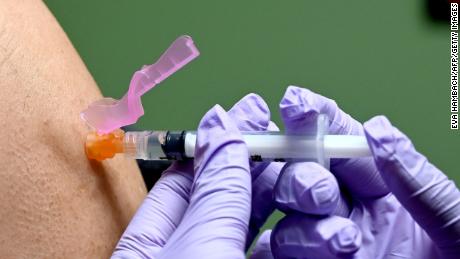“Literally the easiest thing I will do today,” said Gov. Whitmer, who called the press conference to underscore preparations for this coming flu season.
“Preventing the flu will help us save lives and preserve the health care resources we need to continue fighting Covid-19,” she said. “It’s more important than ever.”
Getting a flu shot is a safe, inexpensive way to stay healthy. But in a typical year, less than half of Americans get the vaccination (just 45% last year). Rates in the United Kingdom are comparable, where just 44.9% of registered patients ages 6 months to 64 years old got a flu vaccination from 2018 to 2019. In the European Union, which committed in 2009 to vaccinate at least 75% of residents ages 65 and older, only 45% of people in that group received vaccines in 2018.
With the Covid-19 pandemic spreading rapidly around the globe, distributing the flu vaccine takes on new urgency, according to medical experts.
“Since hospitals and doctors’ offices are going to be very busy caring for Covid-19 patients, a flu vaccine can help decrease burdens on the health care system and make sure that those who need medical care are able to get it,” said Dr. Susan Bailey, president of the American Medical Association and an immunologist in Fort Worth, Texas.
It’s not just to free up resources for Covid-19 patients, though.
“Influenza is a deadly disease in its own right,” Bailey said.
In the 2019 to 2020 flu season, there were between 24,000 and 62,000 deaths from influenza in the United States, according to the US Centers for Disease Control and Prevention, with elderly people, young children and pregnant women at elevated risk. Getting a flu shot not only reduces the odds of getting sick, it often means a less severe illness.
evidence from last spring shows that it may be possible to get both coronavirus and influenza simultaneously. “We saw that in some of the early cases from this year, where patients had other viruses at the same time as they have Covid-19,” Bailey said.
look so similar to Covid-19 symptoms, it will be impossible to rule out a coronavirus diagnosis without a test. That means a case of the flu, even if it turns out to be mild, can cause substantial disruption to work and school.
Getting out the vaccine in a pandemic year
an interview with the AMA’s JAMA Network.
That requires an unprecedented effort to boost flu vaccination rates, and Redfield hopes to push US vaccination rates to 65%. The CDC projects that between 194 million and 198 million doses will be available this year, an increase of nearly 30 million doses from the year before.
To help get vaccines to those in need, the CDC purchased 9.3 million doses of adult flu vaccine and 2 million doses of pediatric flu vaccine. It’s a massive increase over the 500,000 doses the federal agency usually buys for uninsured adults.
workplaces. Amid concerns about large gatherings, that is one less venue for providing flu shots. In addition, the pandemic ushered in an overall
drop in childhood vaccinations. While those numbers have
rebounded in some places, pediatricians remain concerned.
is enabling certified pharmacists to administer flu vaccines to children enrolled in Medicaid, and handing gift cards to members who get their shots.
curbside flu vaccines in Grand Rapids. Drive-through flu shots are also available at some
Kaiser Permanente locations. Flu shots are currently available at many chain drugstores, including
CVS and
Walgreens.
VaccineFinder website, which partners with local health departments and clinics.
Do not proceed without a flu shot
Flu shots can save lives. For some Americans, vaccinations are also a stipulation of in-person work and schooling this year.
announced UC Health in August, a decision that affects more than half a million people.
are also required for children and youth at Massachusetts education facilities, beginning with child care and preschool and going all the way through university. Massachusetts is the first state to introduce such a ruling, and the decision
has sparked protest.
pending bill in the New Jersey legislature would also make flu vaccinations a requirement of enrollment. Vermont is considering a mandate as well, said the state’s health commissioner Dr. Mark Levine in an August 28 press conference.
It’s not all bad news
While the prospect of a double hit of Covid-19 and influenza is alarming, it’s not all doom and gloom.
starts ramping up in October, arrives on the heels of the Southern Hemisphere winter. Because the Northern Hemisphere flu season tends to follow trends from the south, scientists scrutinize numbers in Oceania and South America for clues to what’s coming.
So far, it’s looking pretty good.
“The low levels that we’re seeing are unprecedented,” said Lauren Sauer, an emergency medicine expert and the director of research for the Johns Hopkins Biocontainment Unit. “While we still remain really vigilant, and we’re still concerned for flu season, we’re hopeful that we will have a similar experience when it comes up here.
drops in Chile and South Africa. In part, that could be due to an increase in vaccination rates. A
record number of flu vaccines were made in Australia this year. In Buenos Aires, flu shot clinics sprang up in repurposed day care centers and
churches.
But the downward trend of influenza infections also likely reflects the precautions taken to combat Covid-19.
studies have shown.
Another bright spot is creative solutions to giving vaccinations in a pandemic, which Sauer would like to see outlast Covid-19. “Making it easier for people to get the flu vaccine is incredibly important, and a valuable thing I hope we adopt,” she said, citing efforts to provide vaccinations outside of traditional health care settings.
have been required by Johns Hopkins Medicine, where Sauer works, since 2012. It has worked well.
“It’s such a beneficial approach,” she said. “It’s beneficial for the system, but also for the individual who gets that vaccine, and our patients and our community.”



